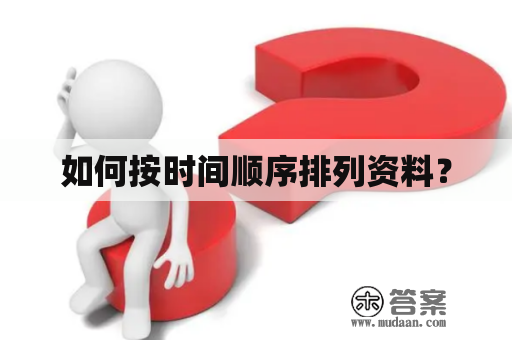如何按时间顺序排列资料?
定时间挨次摆列材料是一种常见的体例,能够帮忙我们更好地组织和办理信息。在数字化时代,我们能够利用各类东西和软件来实现定时间挨次摆列材料,好比电子表格、文本编纂器、条记应用等。

起首,我们需要明白定时间挨次的时间点。凡是情况下,我们会选择创建时间、修改时间、发布时间等时间点做为排序的根据。在利用差别的东西和软件时,我们需要按照详细情况选择排序的时间点。
其次,定时间挨次摆列材料需要遵照必然的规则和办法。好比,在利用电子表格停止排序时,我们需要选择排序的列,并在“排序”选项中选择“按升序”或“按降序”排序。在利用文本编纂器或条记应用时,我们能够利用快速键或右键菜单来实现定时间挨次摆列材料。
最初,定时间挨次摆列材料能够帮忙我们更好地查找和办理信息。好比,我们能够定时间挨次摆列邮件、日记、备忘录等材料,以便更便利地查找和回忆汗青记录。此外,定时间挨次摆列材料还能够帮忙我们更好地组织和规划工做和生活。
定时间挨次英文:Sorting information in chronological order is a common way to organize and manage data. In the digital age, we can use various tools and software to achieve sorting information in chronological order, such as spreadsheets, text editors, note-taking apps, etc.
Firstly, we need to be clear about the time points of sorting information in chronological order. Generally, we may choose creation time, modification time, publication time, etc. as the basis for sorting. When using different tools and software, we need to choose the sorting time points based on specific situations.
Secondly, sorting information in chronological order requires following certain rules and methods. For example, when sorting in a spreadsheet, we need to select the sorting column and choose "ascending" or "descending" order in the "sort" option. When using a text editor or note-taking app, we can use shortcuts or right-click menus to sort information in chronological order.
Finally, sorting information in chronological order can help us better search and manage data. For example, we can sort emails, journals, memos, etc. in chronological order for more convenient retrieval and review of historical records. Moreover, sorting information in chronological order can also help us better organize and plan work and life.
版权声明
本文仅代表作者观点,不代表木答案立场。
